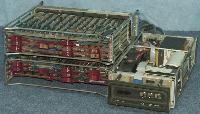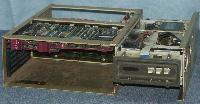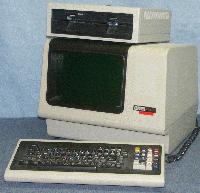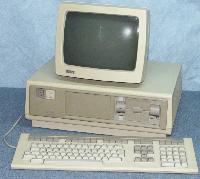Daves Old Computers - Digital Equipment Corp.
Digital Equipment Corporation (DEC), formed in 1957 is one of the best known
names from the minicomputer era. From humble beginings making parts for
other systems, DEC soon created their own PDP (Programmable Data Processor)
line of minicomputers. Best known among these are the PDP-8, one of the earliest
successful general purpose minicomputers, and the PDP-11, arguably the most
popular minicomputer of all time. The PDP-11 was later expanded into the VAX-11,
which was very successful as a larger multi-user system. The company also
produced a few 8-bit "personal computers".
Although I don't have a DEC PDP-8, I do have a
single-board computer based on the Intersil
6100, a single-chip implementation of the PDP-8!
Click any photo to view a large high-resolution image.
 The PDP-11/03 is the first PDP-11 to use the LSI-11 processor chipset,
a PDP-11 implemented in a few large scale IC's. Prior to this PDP-11
processors were several boards filled with logic. A card based system,
the PDP-11 came in many different enclosures and configurations. This
particular system is an "embedded controller" with a very small/light
card cage designed to be protected by the cabinet of the machine it
was controlling. Donated by Kirk Russel.
The PDP-11/03 is the first PDP-11 to use the LSI-11 processor chipset,
a PDP-11 implemented in a few large scale IC's. Prior to this PDP-11
processors were several boards filled with logic. A card based system,
the PDP-11 came in many different enclosures and configurations. This
particular system is an "embedded controller" with a very small/light
card cage designed to be protected by the cabinet of the machine it
was controlling. Donated by Kirk Russel.
 Another PDP-11 - this one has a 11/23 processor - higher integration
(fewer chips), smaller and faster, but still the same PDP-11 instruction
set. Donated by Kirk Russel.
Another PDP-11 - this one has a 11/23 processor - higher integration
(fewer chips), smaller and faster, but still the same PDP-11 instruction
set. Donated by Kirk Russel.
The Digital Equipment Corporation VAX (Virtual Address Extension), originally
called VAX-11 began as a virtual address extension to the famed PDP-11 system.
From there it grew into the VAX-780 series, a line of big-minicomputer/small-mainframe
systems known for it's reliable VMS operating system and powerful DECnet
networking system. Many a company relied on networks of VAX computers to run
day to day operations. Just one look at the VMS
Documentation Set tells you that this is a serious computing platform.
 The MicroVAX II is the first VAX with a single-chip CPU. Based on DECs "Q-BUS"
backplane and interchangable cards, the MicroVAX could be built in many
different configurations of cabinets and peripherals. This particular unit is
housed in a "BS23" desktop cabinet, with an RX50 floppy drive and an internal
hard drive for storage. Donated by Kirk Russel.
The MicroVAX II is the first VAX with a single-chip CPU. Based on DECs "Q-BUS"
backplane and interchangable cards, the MicroVAX could be built in many
different configurations of cabinets and peripherals. This particular unit is
housed in a "BS23" desktop cabinet, with an RX50 floppy drive and an internal
hard drive for storage. Donated by Kirk Russel.
Views:
Back.
 This is the first "tiny" VAX - jumper selectable as either a "VAX 2000"
single-user graphical workstation, or a "MicroVAX 2000" small multiuser system,
this machine can be carried with one hand! (carry handle built into the rear of
the cabinet). Identically sized expansion boxes allow addition of tape drives
and more hard drive space. Donated by Der Mouse, expansion boxes by Kirk Russel.
This is the first "tiny" VAX - jumper selectable as either a "VAX 2000"
single-user graphical workstation, or a "MicroVAX 2000" small multiuser system,
this machine can be carried with one hand! (carry handle built into the rear of
the cabinet). Identically sized expansion boxes allow addition of tape drives
and more hard drive space. Donated by Der Mouse, expansion boxes by Kirk Russel.
Views:
Back,
Mainboard.
I worked with VAXen several times in my career, and the influence of VAX/VMS
can be seen in the user interface of CUBIX, the operating system I wrote for
my D6809 Portable computer.
 This is a VAXstation 3100 - a tiny desktop decendant of DECs mainframe VAX
line. Although it runs the full multi-user VMS operating system, this is
intended as a desktop graphical workstation.
This is a VAXstation 3100 - a tiny desktop decendant of DECs mainframe VAX
line. Although it runs the full multi-user VMS operating system, this is
intended as a desktop graphical workstation.
Views:
Back,
Open,
Mainboard.
 This VAXserver 3100/20 is another small VAX. Intended as a network server,
this unit features extra drive bays and power supply to support more disk
drives. Unlike the VAXstation above, this machine does not support a monitor
and keyboard - you control it via a serial (VT-100) terminal. Donated by
Kirk Russel.
This VAXserver 3100/20 is another small VAX. Intended as a network server,
this unit features extra drive bays and power supply to support more disk
drives. Unlike the VAXstation above, this machine does not support a monitor
and keyboard - you control it via a serial (VT-100) terminal. Donated by
Kirk Russel.
Views:
Back,
Covered-connectors,
Mainboard.
 The smallest (and cutest) VAX, the VAXstation 4000 VLC (Very Low Cost).
This machine uses the "SOC" (System On a Chip) CPU, a single-chip VAX
implementation. Although tiny, this machine can run the full VMS
multi-user system. Donated by Kirk Russel.
The smallest (and cutest) VAX, the VAXstation 4000 VLC (Very Low Cost).
This machine uses the "SOC" (System On a Chip) CPU, a single-chip VAX
implementation. Although tiny, this machine can run the full VMS
multi-user system. Donated by Kirk Russel.
Views:
Back,
Open.
 The VT-180 "Robin" is actually a standard VT-100 terminal, with an
extra board that gives it the ability to
interface to external drives and run the CP/M operating system. It can
still function as a VT-100 terminal as well. Shown on top is the RX-180
dual diskette drive system.
The VT-180 "Robin" is actually a standard VT-100 terminal, with an
extra board that gives it the ability to
interface to external drives and run the CP/M operating system. It can
still function as a VT-100 terminal as well. Shown on top is the RX-180
dual diskette drive system.
View from the back with the rear panel removed
so that you can see inside the card cage.
VT-180 donated by
Rob Krten and Kirk Russel,
drives by Mike Kenzie.
 The Rainbow 100+ is a unique dual processor machine which bridges the gap between
Z80 based CP/M and 8086 based MS-DOS and CP/M-86. The Rainbow CP/M is a special
dual processor version which can run either Z80 or 8086 software. In typical
DEC fashion, the machine can also be used as a VT-100 terminal. Another interesting
aspect of the design is that the cover and subassemblies can be removed without
any tools.
The Rainbow 100+ is a unique dual processor machine which bridges the gap between
Z80 based CP/M and 8086 based MS-DOS and CP/M-86. The Rainbow CP/M is a special
dual processor version which can run either Z80 or 8086 software. In typical
DEC fashion, the machine can also be used as a VT-100 terminal. Another interesting
aspect of the design is that the cover and subassemblies can be removed without
any tools.
Views:
Back,
Inside,
Documentation.
Donated by Richard Parsons.
VT-18X Upgrade and System Test Guide (4.8M PDF)
VT-180 Technical Manual (14M PDF)
VT-180 BIOS and Boot Track source code (19k ZIP)
Rainbow Frequently Asked Questions (16k ZIP)
CP/M version 2.2 Manual (0.5M PDF)
Z80 CPU Technical Manual (5M PDF)
Z80-CP/M emulator
Z80-CP/M simulator - boots CP/M
Back to Old Computers
Copyright 2004-2008 Dave Dunfield.
 The PDP-11/03 is the first PDP-11 to use the LSI-11 processor chipset,
a PDP-11 implemented in a few large scale IC's. Prior to this PDP-11
processors were several boards filled with logic. A card based system,
the PDP-11 came in many different enclosures and configurations. This
particular system is an "embedded controller" with a very small/light
card cage designed to be protected by the cabinet of the machine it
was controlling. Donated by Kirk Russel.
The PDP-11/03 is the first PDP-11 to use the LSI-11 processor chipset,
a PDP-11 implemented in a few large scale IC's. Prior to this PDP-11
processors were several boards filled with logic. A card based system,
the PDP-11 came in many different enclosures and configurations. This
particular system is an "embedded controller" with a very small/light
card cage designed to be protected by the cabinet of the machine it
was controlling. Donated by Kirk Russel.







